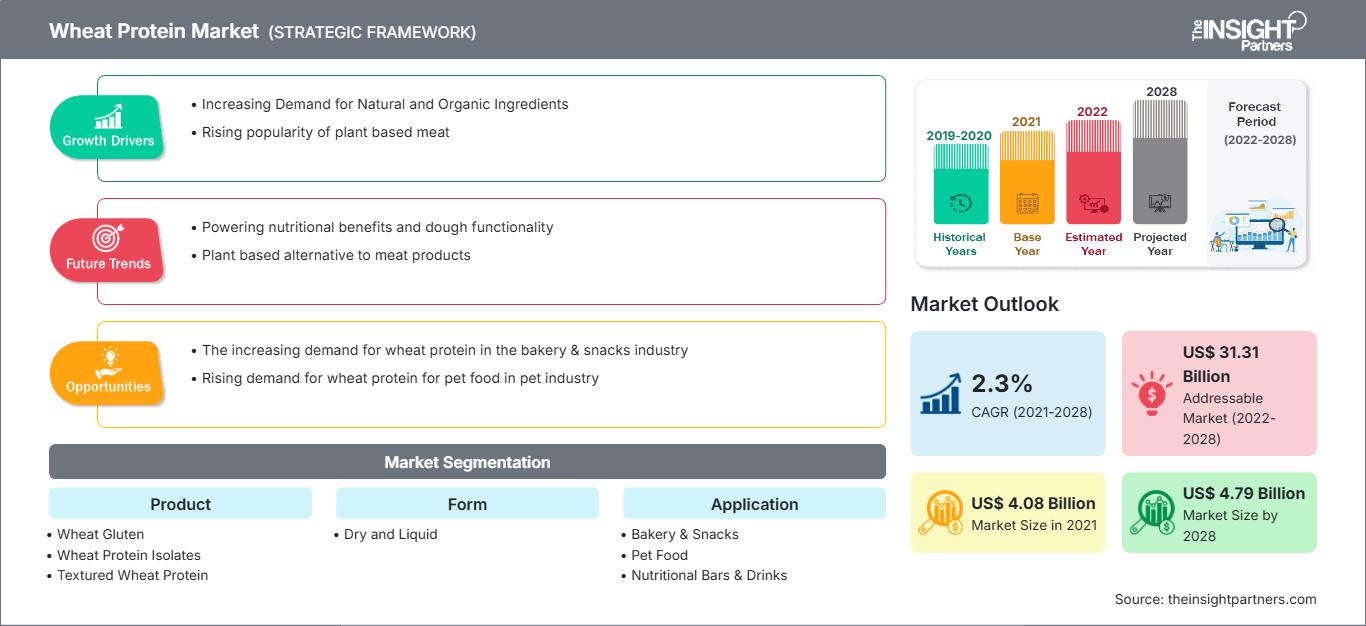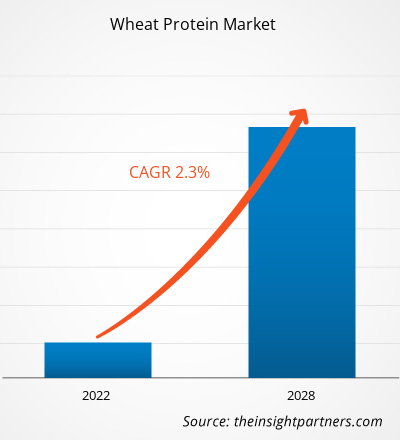[Rapporto di ricerca]Il mercato delle proteine del grano è stato valutato a 4.083,05 milioni di dollari nel 2021 e si prevede che raggiungerà i 4.788,49 milioni di dollari entro il 2028; si prevede una crescita a un CAGR del 2,3% dal 2021 al 2028.
Le proteine del grano sono proteine di origine vegetale ottenute principalmente dalla lavorazione del grano con diversi enzimi. Sono proteine funzionali insolubili che possiedono caratteristiche viscoelastiche uniche e offrono elasticità ed estensibilità al prodotto finale. Queste proteine sono considerate una valida alternativa alle proteine di origine animale. Sono ampiamente utilizzate in diversi settori di utilizzo finale, come panetteria e pasticceria, cosmetici e cura della persona, mangimi per animali e integratori alimentari.
Nel 2020, l'Europa deteneva la quota di fatturato maggiore del mercato globale delle proteine del grano. Il mercato europeo è segmentato in Germania, Francia, Italia, Regno Unito, Russia e resto d'Europa. La crescente consapevolezza della salute tra i consumatori stimola la domanda di numerosi prodotti proteici vegetali, come soia, grano e avena. La popolarità delle proteine del grano è aumentata in tutta la regione, in particolare in Germania, Francia e Regno Unito. Gli europei stanno adottando sempre più la dieta flessibile, ovvero la sostituzione di parte o della maggior parte del consumo di carne con alimenti proteici alternativi. Questi fattori alimentano la domanda di prodotti proteici a base di grano in Europa.
Personalizza questo rapporto in base alle tue esigenze
Potrai personalizzare gratuitamente qualsiasi rapporto, comprese parti di questo rapporto, o analisi a livello di paese, pacchetto dati Excel, oltre a usufruire di grandi offerte e sconti per start-up e università
Mercato delle proteine del grano: Approfondimenti strategici

-
Ottieni le principali tendenze chiave del mercato di questo rapporto.Questo campione GRATUITO includerà l'analisi dei dati, che vanno dalle tendenze di mercato alle stime e alle previsioni.
Molti settori, come quello alimentare e delle bevande, hanno dovuto affrontare sfide senza precedenti a causa della pandemia di COVID-19. A causa della carenza di materie prime, della chiusura degli stabilimenti, della carenza di manodopera e di altre difficoltà operative nell'ambito dei protocolli di sicurezza COVID-19, le aziende impegnate nella produzione di proteine del grano hanno dovuto affrontare difficoltà durante i primi mesi della pandemia. Il settore alimentare e delle bevande è il principale consumatore di proteine del grano e la pandemia di COVID-19 in corso ha influenzato negativamente la domanda di questo tipo di prodotti. I prodotti alimentari e delle bevande, come prodotti da forno, dolciumi e latticini, stanno subendo una battuta d'arresto poiché i supermercati hanno riallocato le priorità di stoccaggio verso prodotti di base e beni essenziali a causa dell'epidemia. Tuttavia, con la ripresa delle economie, si prevede che la domanda di proteine del grano aumenterà a livello mondiale nei prossimi mesi. La pandemia di COVID-19 ha portato a un aumento della domanda di prodotti da forno sani e funzionali, che si prevede alimenterà la crescita del mercato delle proteine del grano nei prossimi anni.
Approfondimenti di mercato
Crescente domanda di ingredienti naturali e biologici
L'importanza degli alimenti biologici è stata compresa sulla scia di allarmanti problemi di salute, unitamente a una crescente consapevolezza delle certificazioni biologiche e alla crescente preferenza per prodotti alimentari di alta qualità. Oggigiorno, i consumatori cercano ingredienti naturali, puliti e semplici con etichette adeguate, che possano comunicare efficacemente il loro contenuto, la qualità e lo scopo dell'uso del prodotto. Inoltre, dipendono in larga misura da prodotti alimentari biologici e naturali. Ad esempio, il consumo di proteine del grano biologiche è aumentato notevolmente in diversi settori applicativi, come quello alimentare e delle bevande e quello dei mangimi per animali e pesci. Pertanto, i produttori di proteine del grano si stanno concentrando sullo sviluppo e la commercializzazione di proteine del grano biologiche.
Approfondimenti sui prodotti
In base al prodotto, il mercato globale delle proteine del grano è segmentato in glutine di grano, isolati proteici del grano, proteine del grano testurizzate e proteine del grano idrolizzate. Nel 2020, il segmento del glutine di grano ha rappresentato la quota di fatturato maggiore. Il glutine di grano vitale viene utilizzato come additivo in pasticceria. Aggiunge elasticità alle farine, che altrimenti sarebbero povere di glutine, come la farina integrale o di segale. Il glutine di grano migliora anche la lievitazione dell'impasto crudo e migliora la consistenza e la masticabilità del prodotto finale.
Approfondimenti sulla forma
Il mercato delle proteine del grano, in base alla forma, è suddiviso in secco e liquido. Nel 2020, il segmento secco ha rappresentato una quota di fatturato maggiore. Alcune delle proprietà delle proteine del grano secche sono l'elevata solubilità in acqua a qualsiasi pH, la capacità di legare l'acqua e di emulsionare, la bassa viscosità e la stabilità acida e termica. Le proteine del grano secche sono sempre più utilizzate nei prodotti da forno, negli alimenti per animali domestici, nelle barrette nutrizionali, nelle carni lavorate e nei prodotti analoghi della carne. Pertanto, le ampie applicazioni nell'industria alimentare stanno sostenendo la crescita del mercato del segmento secco.
Approfondimenti sulle applicazioni
Il mercato delle proteine del grano, per applicazione, è segmentato in prodotti da forno e snack, alimenti per animali domestici, barrette nutrizionali e bevande, carni lavorate, prodotti analoghi della carne e altri. Nel 2020, il segmento dei prodotti da forno e degli snack ha rappresentato la quota di fatturato maggiore. Numerosi prodotti da forno, come panini, pane, biscotti, pasticcini, torte e muffin, sono popolari tra i consumatori. Le proteine del grano sono tra gli ingredienti comuni che ottimizzano il comportamento dell'impasto e migliorano le proprietà nutrizionali dei prodotti finali. La crescente domanda di proteine del grano nel settore della panetteria e degli snack L'industria degli snack e la tendenza delle etichette pulite stanno creando ampie opportunità per gli operatori che operano nel mercato mondiale delle proteine del grano.
Archer Daniels Midland Company; Roquette Frères; Glico Nutrition Co., Ltd; Kröner-Stärke GmbH; Cargill, Incorporated; Crespel & Deiters GmbH & Co. KG; CropEnergies AG; Manildra Group; MGP Ingredients Inc.; e Tereos Group sono alcuni degli operatori consolidati nel mercato globale delle proteine del grano. Le aziende del mercato stanno adottando diverse strategie, come lo sviluppo di prodotti, l'espansione degli stabilimenti e fusioni e acquisizioni, per espandere la propria presenza a livello mondiale e soddisfare la crescente domanda degli utenti finali. Ad esempio, nel 2020, Archer Daniels Midland Company ha sviluppato nuovi prodotti. I prodotti contengono proteine di piselli testurizzate Arcon T, proteine di grano testurizzate Prolite MeatTEX e proteine di grano non testurizzate Prolite MeatXT.
In evidenza nel rapporto
- Tendenze progressive del settore nel mercato globale delle proteine del grano per aiutare gli operatori a sviluppare strategie efficaci a lungo termine
- Strategie di crescita aziendale adottate dai mercati sviluppati e in via di sviluppo
- Analisi quantitativa del mercato globale delle proteine del grano dal 2019 al 2028
- Stima della domanda di proteine del grano in vari settori
- Sviluppi recenti per comprendere lo scenario competitivo del mercato e la domanda di proteine del grano
- Tendenze e prospettive di mercato insieme ai fattori che guidano e frenano la crescita del mercato delle proteine del grano
- Processo decisionale attraverso la comprensione delle strategie che sostengono l'interesse commerciale per quanto riguarda la crescita del mercato globale delle proteine del grano
- Dimensioni del mercato delle proteine del grano in vari nodi del mercato
- Panoramica dettagliata e segmentazione del mercato globale mercato delle proteine del grano e le sue dinamiche nel settore
- Dimensioni del mercato delle proteine del grano in varie regioni con promettenti opportunità di crescita
Approfondimenti regionali sul mercato delle proteine del grano
Le tendenze regionali e i fattori che influenzano il mercato delle proteine del grano durante il periodo di previsione sono stati ampiamente spiegati dagli analisti di The Insight Partners. Questa sezione illustra anche i segmenti e la geografia del mercato delle proteine del grano in Nord America, Europa, Asia-Pacifico, Medio Oriente e Africa, America meridionale e centrale.
Ambito del rapporto sul mercato delle proteine del grano
| Attributo del rapporto | Dettagli |
|---|---|
| Dimensioni del mercato in 2021 | US$ 4.08 Billion |
| Dimensioni del mercato per 2028 | US$ 4.79 Billion |
| CAGR globale (2021 - 2028) | 2.3% |
| Dati storici | 2019-2020 |
| Periodo di previsione | 2022-2028 |
| Segmenti coperti |
By Prodotto
|
| Regioni e paesi coperti |
Nord America
|
| Leader di mercato e profili aziendali chiave |
|
Densità degli operatori del mercato delle proteine del grano: comprendere il suo impatto sulle dinamiche aziendali
Il mercato delle proteine del grano è in rapida crescita, trainato dalla crescente domanda da parte degli utenti finali, dovuta a fattori quali l'evoluzione delle preferenze dei consumatori, i progressi tecnologici e una maggiore consapevolezza dei benefici del prodotto. Con l'aumento della domanda, le aziende stanno ampliando la propria offerta, innovando per soddisfare le esigenze dei consumatori e sfruttando le tendenze emergenti, alimentando ulteriormente la crescita del mercato.

- Ottieni il Mercato delle proteine del grano Panoramica dei principali attori chiave
Mercato delle proteine del grano, per
- Prodotto
- Glutine di frumento
- Proteine del grano isolate
- Proteine del grano testurizzate
- Proteine del grano idrolizzate
Mercato delle proteine del grano, per Forma
- Secca
- Liquida
Mercato delle proteine del grano, per applicazione
- Panetteria e prodotti da forno; Snack
- Cibo per animali domestici
- Barrette nutrizionali e snack Bevande
- Carne lavorata
- Analogamente alla carne
- Altri
Profili aziendali
- Archer Daniels Midland Company
- Roquette Frères
- Glico Nutrition Co.,Ltd
- Kröner-Stärke GmbH
- Cargill, Incorporated
- Crespel & Deiters GmbH & Co. KG
- CropEnergies AG
- Manildra Group
- MGP Ingredients Inc.
- Tereos Group
- Analisi storica (2 anni), anno base, previsione (7 anni) con CAGR
- Analisi PEST e SWOT
- Valore/volume delle dimensioni del mercato - Globale, Regionale, Nazionale
- Industria e panorama competitivo
- Set di dati Excel
Report recenti
Testimonianze
Motivo dell'acquisto
- Processo decisionale informato
- Comprensione delle dinamiche di mercato
- Analisi competitiva
- Analisi dei clienti
- Previsioni di mercato
- Mitigazione del rischio
- Pianificazione strategica
- Giustificazione degli investimenti
- Identificazione dei mercati emergenti
- Miglioramento delle strategie di marketing
- Aumento dell'efficienza operativa
- Allineamento alle tendenze normative






















 Ottieni un campione gratuito per - Mercato delle proteine del grano
Ottieni un campione gratuito per - Mercato delle proteine del grano